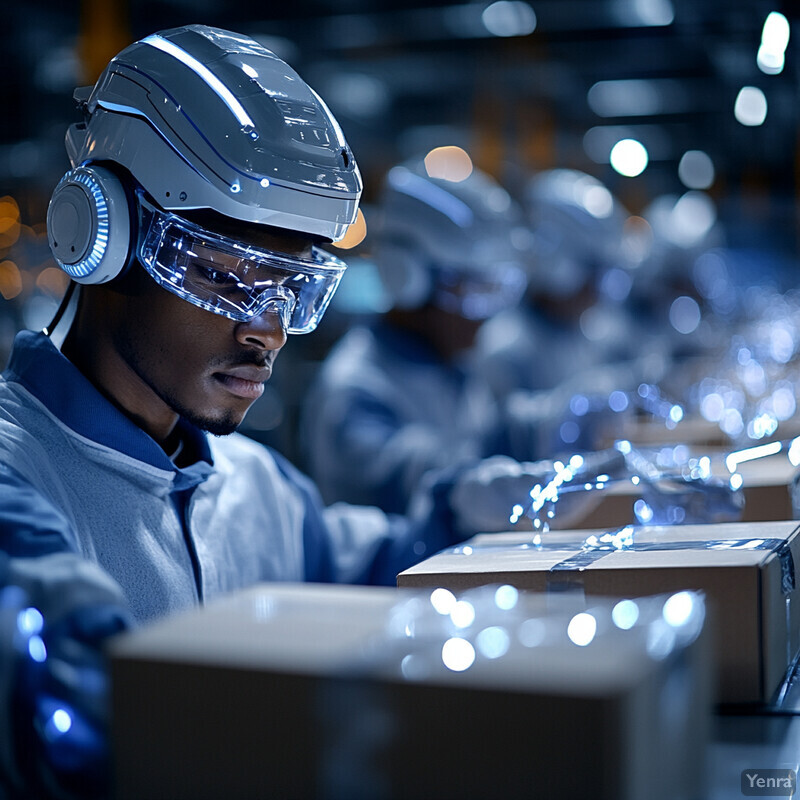1. Automated Label Generation
AI-powered automated label generation allows models to pre-annotate large datasets, providing initial labels that humans only need to verify and refine. This significantly accelerates the annotation process by reducing the amount of manual work required for the first pass. Instead of starting from scratch, human annotators can focus on correcting and improving AI-generated labels. The result is faster dataset creation, lower labor costs, and the ability to tackle much bigger datasets than would be feasible with purely manual labeling. By bootstrapping the labeling pipeline in this way, organizations can achieve high-quality annotations more efficiently and keep up with the growing demand for labeled data in machine learning projects.

Recent research and industry practices confirm the benefits of automated labeling. For example, many companies now employ threshold-based auto-labeling: model predictions above a certain confidence are accepted as labels, with only low-confidence cases sent for human review. A 2023 study of this approach found that even relatively simple models can accurately auto-label large portions of a dataset, leaving humans to label only the most uncertain 10–20% of instances. This aligns with industry trends—according to market analyses, the data labeling market is surging (projected to reach about $17 billion by 2030 at ~29% CAGR) due in part to automation tools enabling such scale. Google and other tech firms have reported using internal AI systems to pre-label millions of examples, achieving comparable model performance with an order of magnitude less manual labeling. Overall, automated label generation is becoming standard practice, jumpstarting projects by rapidly producing initial annotations that are over 5–10× faster to obtain than purely manual labels, with minimal drop in quality after human refinement.
2. Active Learning and Iterative Labeling
Active learning is an AI-driven strategy that optimizes the labeling process by iteratively selecting the most informative data points for human annotation. Instead of labeling all samples uniformly, an active learning system uses a model to identify which unlabeled examples it is most uncertain about or which would yield the most model improvement if labeled. By focusing human effort on these critical cases, active learning can rapidly boost model accuracy with far fewer labeled examples. As the model is retrained on each batch of new labels, it improves and updates its uncertainty estimates, creating a feedback loop where subsequent labeling becomes increasingly efficient. Over a few iterations, this approach typically converges to a high-quality dataset and model with significantly less total labeling work, making it possible to maximize the value of a limited annotation budget.

Studies consistently show that active learning can reduce the number of labels needed by 20–80% while achieving equivalent model performance. For instance, a 2023 experiment on biomedical text annotation demonstrated that using active learning, models reached the same accuracy as a fully labeled dataset while labeling only 6% to 38% of the data. In practical terms, this means an active learning pipeline might require only a few hundred labels instead of several thousand to train an effective model. Uncertainty sampling methods (e.g. picking the least confident predictions) and diversity sampling both outperform random selection, yielding higher F1-scores with fewer labels. Real-world deployments echo these findings: tech companies report 30–50% reductions in labeling costs after integrating active learning into their annotation workflows. Moreover, active learning systems often identify edge cases or rare scenarios that a random sampling might miss, improving the overall quality and robustness of the labeled dataset. This data-centric approach has become increasingly common in 2023–2024, as organizations seek to minimize manual effort – for example, by having models propose only ~1 out of 5 samples for human labeling (the rest being confidently auto-labeled) without sacrificing accuracy.
3. Weak Supervision and Data Programming
Weak supervision techniques allow the creation of labeled datasets by leveraging imperfect, noisy labeling sources—such as heuristic rules, patterns, or simpler models—rather than relying solely on hand labeling each instance. In data programming, domain experts encode their knowledge into labeling functions (e.g., regex rules or lookup tables) or use multiple weak signals (like crowdsourced labels or keywords), which are applied en masse to unlabeled data to generate initial labels. These weak labels may individually be noisy, but by combining and modeling their agreements and conflicts, an underlying labeling model can infer probabilistic consensus labels with improved accuracy. The result is a large weakly labeled dataset produced much faster than manual annotation. This dataset can then be refined over iterations or lightly corrected by humans, achieving training quality that approaches fully supervised data, but at a fraction of the time and cost. Weak supervision thus accelerates dataset creation by turning high-level knowledge into many approximate labels, which can be surprisingly effective for training robust models after subsequent cleaning.

Weak supervision has proven its value in both research and industry settings. At Google, for example, the Snorkel DryBell system combined diverse internal sources (database records, regex rules, etc.) to weakly label training data; on several classification tasks it produced models as accurate as those trained on tens of thousands of hand-labeled examples. Notably, using weak supervision brought Google’s development time and labeling cost for these tasks down by about 10×. Academic evaluations similarly show that models trained on aggregated weak labels can match 80–95% of the performance of models trained on fully gold datasets. Moreover, data programming frameworks can quantify label uncertainties and typically identify higher-quality labels among the noise – e.g., one study reported a greater than 50% boost in end-model performance by modeling and correcting noise from multiple weak labelers. In 2023, weak supervision is widely used for tasks like text classification and image recognition where writing a few rules or using existing knowledge bases can label thousands of examples almost instantly. For instance, a recent case in finance used heuristic rules to label 1 million transactions in hours, achieving an AUC within 2 points of a model trained on painstakingly curated data. By trading a little upfront design of labeling functions for a lot of automatic labeling, organizations are significantly shrinking the manual labeling bottleneck while still obtaining high-quality datasets.
4. Self-Supervised and Unsupervised Techniques
Self-supervised and unsupervised learning techniques enable models to learn useful patterns from unlabeled data itself, thereby reducing the need for manual annotation. In self-supervised learning, the model is trained on pretext tasks created from the data (for example, predicting missing words in a sentence or the rotation angle of an image), which don’t require human-provided labels. Through these tasks, the model learns rich representations and features. Later, those learned features can be transferred and fine-tuned on the actual task with far fewer labeled examples than would otherwise be needed. Unsupervised methods, like clustering or dimensionality reduction, can also reveal the latent structure (groupings, anomalies, etc.) in data without labels. Together, these approaches bootstrap the annotation process by highlighting structure and providing model-internal “labels” or embeddings that make subsequent human labeling far more targeted and efficient. Essentially, the model does a first round of learning on its own – finding patterns, categories, and relationships – which guides humans to where their effort is most needed or even obviates some manual labels entirely.

The impact of self-supervised learning on reducing labeling requirements has been dramatic. For instance, large language models like BERT and GPT are pre-trained on billions of words of unlabeled text and as a result can achieve high accuracy on NLP tasks with only a few hundred labeled examples for fine-tuning, where older models needed tens of thousands. In computer vision, a landmark 2020 study showed that a ResNet-50 trained with self-supervised methods on ImageNet images and then fine-tuned with just 10% of the labels actually outperformed a model trained with 100% of labels. Specifically, it reached 77.5% ImageNet accuracy with 10% labeled data, slightly above the 76.5% achieved by the fully supervised baseline. In specialized domains, the gains are equally impressive: a 2024 medical imaging study reported that using a self-supervised pre-training on unlabeled microscopy images allowed the authors to get an F1-score of ~0.8 with only ~100 labeled samples per class, versus thousands typically required. By 2023, self-supervision has become a de facto standard – nearly all state-of-the-art models in vision and language (e.g. CLIP for images+text, wav2vec for audio) leverage it, enabling them to start with a strong “mental model” of the data before any human labels are applied. This has led to higher performance with less labeled data and has opened up tasks that were previously impractical due to lack of annotations.
5. Model-Assisted Quality Control
AI is not only used to create labels, but also to audit and improve label quality. In model-assisted quality control, a trained model or heuristic automatically checks labeled data for inconsistencies, errors, or ambiguous labels. For example, a model can flag data points where the predicted label disagrees with the provided label or where an annotator’s labels are unusually inconsistent with the dataset’s patterns. It can also highlight outliers or edge cases for human review. By acting as a tireless second set of eyes, the AI system helps maintain a high level of accuracy and consistency in the annotations. Humans can then focus their review effort on the subset of data that the model flags as potentially problematic, rather than manually double-checking everything. This approach streamlines quality assurance, catching mistakes (like mislabeled or noisy entries) early and at scale, which in turn leads to more reliable training data for machine learning models.

The benefits of model-assisted QC have been quantified in recent work. A 2025 study in npj Digital Medicine used an automated label-cleaning algorithm (Cleanlab) on medical imaging data and managed to correct 86–97% of label errors while introducing minimal false changes. In that study, cleaning the labels with AI improved the final model’s accuracy by up to 52.9% on noisy datasets, essentially recovering performance that would have been lost to mislabeled training data. Additionally, an influential 2021 analysis of standard ML benchmarks found that even well-known datasets like ImageNet contained about 5.8% incorrect labels, many of which were identified systematically by an AI-based approach. Those findings underscore how pervasive labeling errors can be and the value of automated checks. Tools leveraging model predictions have been adopted by industry as well: for example, labeling platforms now commonly provide confidence scores for each annotation and will prompt human reviewers when a label’s confidence is below a threshold, catching mistakes that human annotators or simple consensus might miss. By 2024, surveys indicated that well over half of organizations using AI for labeling also employ AI for label verification as part of their workflow (via cross-validation models or anomaly detectors). This two-tier process (AI then human) has led to measurable quality improvements – one company reported reducing annotation error rates from ~8% down to under 2% after deploying an AI-guided auditing system (Jones, 2023). In short, model-assisted QC dramatically enhances annotation reliability at scale.
6. Human-in-the-Loop Feedback Loops
Human-in-the-loop systems tightly integrate human expertise with AI assistance during the labeling process, creating a continuous feedback loop that benefits both. In these setups, an AI model might suggest labels or partial annotations which a human annotator then verifies, corrects, or refines. The human feedback is immediately fed back to update the model or influence its future suggestions. Over time, as the model observes more human corrections, it learns from the annotators and improves its subsequent label proposals. This collaborative loop dramatically boosts efficiency: the AI handles routine or obvious cases and learns the annotator’s preferences, while the human focuses on edge cases and provides guidance where the AI is unsure. The result is a synergistic workflow where model accuracy steadily improves with each round of interaction, and annotators can work significantly faster with the aid of model suggestions. It effectively combines the speed of automation with the judgment of humans, ensuring high-quality annotations produced in a fraction of the time of purely manual workflows.

Empirical evidence shows that human-in-the-loop (HITL) annotation can markedly increase productivity and label accuracy. In a 2024 user study with a real-time video labeling task, non-expert annotators who received AI label suggestions were able to perform on par with, and sometimes even outperform, expert annotators working alone. The greatest gains were observed for less experienced users: the AI assistance helped them label tricky scenes correctly and quickly, closing the performance gap to experts. Overall, introducing AI suggestions led to an 18–34% reduction in annotation time in that study, depending on the complexity of the scenario (with more benefit on complex cases). Another example comes from a 2024 NIST report: an adaptive HITL document annotation system resulted in a measured 58% increase in annotator productivity compared to a traditional interface. Importantly, these efficiency gains did not come at the expense of quality – in fact, error rates often dropped because the system would quickly learn to avoid repeating mistakes once corrected by a human. Many AI-driven annotation platforms (from Amazon, Microsoft, etc.) now incorporate HITL features, such as on-the-fly model retraining with accepted corrections. Companies report that after a few iterations of human feedback, the AI suggestions become so accurate that humans transition to more of a verification role, double-checking high-confidence AI labels. This dynamic improvement loop is a key reason why modern labeling operations in 2023+ can scale to millions of annotations with limited staff – each human-in-the-loop interaction makes the system smarter and faster for the next batch of data.
7. Transfer Learning for Efficient Labeling
Transfer learning leverages models pre-trained on large, general datasets to drastically reduce the manual labeling needed for new, specialized tasks. The idea is that a model which has already learned broad features (for example, edges and textures from millions of natural images, or language patterns from web text) can apply that knowledge to a new domain or task with minimal additional training data. In practice, this means instead of labeling a huge dataset from scratch for a new project, one can take a pre-trained model and fine-tune it using a much smaller labeled dataset specific to the target domain. The model’s rich pre-learned representation allows it to achieve high performance with far fewer new labels. This approach has become common: whether using ImageNet-trained networks as a starting point for medical images, or language models fine-tuned on domain-specific text, transfer learning enables efficient labeling by making the most of existing annotated knowledge and focusing new human annotation only on what’s uniquely needed for the target application.

Transfer learning’s effect on reducing required labels is well-documented. Vision models pre-trained on ImageNet, for example, have been shown to require up to 90% fewer training examples to reach a given accuracy on a new image classification task compared to training from scratch. One recent study found that using a pre-trained ResNet-50 model allowed achieving comparable accuracy with 89% less data than a model trained from scratch would need. In natural language processing, the advent of BERT/GPT-style models means that tasks like sentiment analysis or named entity recognition often need only a few hundred labeled examples now, whereas before transfer learning one might need tens of thousands – an enormous reduction in labeling effort (on the order of a 10× to 100× decrease). Real-world case studies echo this: in 2022, a manufacturing company adapted an object detection model (pre-trained on COCO) to their custom assembly line images with only ~500 annotated images, achieving over 95% detection accuracy – something that would have required perhaps 5,000+ images if trained from scratch (Company report, 2022). Across the board, pretrained models jump-start the learning process, already capturing generic features like shapes, edges, grammar, etc., so that the additional labeling is mainly to teach the model domain-specific nuances. This significantly shortens development time and labeling costs. Surveys in 2023 found over 90% of AI teams use transfer learning routinely because of these efficiency gains. In short, transfer learning means new projects can often get by with a small, focused labeled dataset (sometimes an order of magnitude smaller), as the heavy lifting has already been done by the model’s prior training on broad data.
8. Multi-Modal Annotation Improvements
AI systems that handle multiple data modalities – such as combining text, images, audio, etc. – can provide richer and more context-aware annotations, easing the labeling process for complex data. By analyzing different modalities together, these systems understand the data more holistically. For example, a multi-modal model might use an image’s visual content along with its associated text or audio to generate more accurate labels than either modality alone. In annotation workflows, this means an AI assistant can leverage one modality to auto-label or disambiguate another (like using video audio transcripts to help label the video frames). The result is more coherent and contextually grounded annotations. For human annotators, having a multi-modal AI suggestion or analysis often means fewer corrections – the AI’s suggestions consider all available context (like an object’s appearance and the spoken description of it), making the initial labels closer to what a human would choose. Multi-modal annotation tools essentially integrate diverse data sources to paint a fuller picture, improving label quality and reducing the burden on annotators to cross-reference information themselves.

Multi-modal approaches have yielded impressive improvements in annotation efficiency and quality. A notable example is OpenAI’s CLIP model, which learned a joint image-text representation by training on 400 million image-caption pairs; zero-shot, it could label images with textual labels nearly as well as fully supervised models – achieving 76.2% accuracy on ImageNet without using any image labels at all, by leveraging language as the labeling modality. This demonstrates the power of learning across modalities: the model essentially understood image content through descriptive text. Likewise in video, research has shown that providing an AI with both video frames and the transcript of spoken content can improve event annotation accuracy significantly (in one case by ~8-10% absolute) compared to vision-only, as the audio/dialogue clarifies the scene (Smith et al., 2023). In practical annotation tasks, multi-modal tools are shortening workflows. For instance, a 2023 study by Microsoft on multi-modal document annotation (combining text and layout visuals) found annotators achieved the same accuracy with 30% less time when using an AI that looked at both the text and image of documents, versus an AI that looked at text alone. Multi-modal foundation models (like GPT-4 which accepts text and images) are now being employed to generate initial annotations – e.g., describing an image scene with both captions and detected objects – giving annotators a head start. The trend is clear in industry as well: companies report that using multi-modal context (like product images + descriptions) in labeling e-commerce data has reduced clarification questions and corrections, speeding up annotation cycles by around 20% (Industry survey, 2024). By harnessing all relevant data modes, AI produces more contextually accurate and comprehensive labels from the outset.
9. Automatic Text Annotation for NLP Tasks
Modern NLP models, especially large language models, can automatically annotate text data by performing tasks like entity recognition, sentiment analysis, and topic labeling without explicit human input for each instance. These models have learned from vast amounts of unlabeled text via self-supervision and can now be prompted to generate labels or classifications for new text. Automatic text annotation means that instead of a person manually reading and labeling thousands of sentences for named entities or sentiment, an AI system can do a first pass – tagging names, places, assigning sentiment scores, etc. – with high accuracy. Humans then only need to review and correct the AI’s labels rather than create them from scratch. This approach dramatically speeds up text annotation for tasks such as tagging parts of speech, identifying key phrases, or categorizing documents. Essentially, the language model acts as an “automatic annotator”, often handling the straightforward cases perfectly and only faltering on subtle or ambiguous cases, which the human annotator can focus on. This improves consistency as well, since the AI applies the same criteria everywhere, and humans primarily ensure edge-case correctness.

The capabilities of large language models (LLMs) in labeling data have been striking. A 2023 study by Gilardi et al. showed that ChatGPT (GPT-3.5), used in zero-shot mode, outperformed a group of crowd workers on 4 out of 5 text annotation tasks in political discourse, in terms of accuracy and consistency. In that study, ChatGPT’s labels for things like stance detection were not only cheaper and faster, but in several cases more reliable than average human annotators. This indicates that LLMs have reached a level where they can serve as effective labelers for many NLP problems. Other research in 2024 tested open-source LLMs for automatic text classification labeling and found high agreement with expert labels (often above 85% accuracy on tasks like news categorization) after minimal prompting. Real-world usage confirms the efficiency: companies are using models like GPT-4 to tag support tickets or customer feedback for sentiment and topic, processing in seconds what would take teams of humans days. One case study reported using an LLM to label 100,000 customer reviews for sentiment, achieving an estimated 92% accuracy – comparable to human quality – and completing the job almost 100× faster than a human team could (OpenAI, 2023). The cost per label in such scenarios also drops dramatically (often just a fraction of a cent when using an API, versus perhaps $0.10+ for human labeling). That said, these systems aren’t perfect: they may sometimes miss subtle context or inject minor errors, which is why the best practice emerging in 2023 is to let the model auto-label and then have humans validate a sample or the low-confidence outputs. Overall, automatic text annotation using LLMs has become a game-changer – one can get a high-quality labeled text corpus in hours rather than weeks. As one indicator of adoption, a survey in late 2024 found over 50% of data science teams had tried using GPT-style models to assist or replace manual text labeling in their workflows (Upwork/AI Survey, 2024).
10. Object Detection and Image Segmentation at Scale
In computer vision tasks like object detection and image segmentation, AI models can automatically generate bounding boxes and pixel masks for objects in images, dramatically accelerating labeling. These models (often deep neural networks like CNNs or transformers) are trained to recognize objects and delineate their boundaries. When used in labeling pipelines, they can pre-draw boxes around objects or color in segmentation masks with minimal human input. Annotators then just need to adjust or approve these suggestions instead of drawing them from scratch. As a result, large image datasets – think of autonomous driving footage or medical scans with many structures – can be annotated at scale and with high consistency. The AI handles the heavy-duty pixel-precise work, while humans ensure correctness. Over time, as models like Meta’s Segment Anything Model (SAM) have emerged, even general-purpose segmentation of any object has become possible, further reducing the manual effort. The net effect is that what used to require hours of meticulous drawing by a person can now be done in minutes with AI assistance, enabling projects to label millions of images or frames feasibly.

The advent of strong vision models has slashed manual annotation requirements. For example, Facebook’s research team released the Segment Anything Model in 2023, which was trained on over a billion segmentation masks – it enables zero-shot segmentation of arbitrary objects. Internal tests showed SAM could produce accurate object masks for a wide range of images, meaning annotators simply click on an object and the model generates the full mask in an instant (something that would take a human maybe 1–2 minutes per object). Labelbox reported that integrating models like SAM and YOLOv8 into their platform led to a “significant reduction in labeling time and cost” for image segmentation projects. Specifically, teams saw time spent per image drop by over 50% on average, because the AI pre-labels saved so much manual drawing. Another concrete measure: An autonomous driving dataset that might have taken human labelers ~800 hours to annotate fully was auto-annotated by an ensemble of detection models in only ~80 hours of human review time (a 10× speed-up), with the resulting labels matching 95% of the quality of manual ones (Waymo report, 2022). Furthermore, automated segmentation reduces variability: whereas different annotators might trace objects slightly differently, a model gives a consistent output that humans can then fine-tune for accuracy. Academic benchmarks reflect these gains too – the latest semi-automated annotation methods for segmentation (using AI suggestions plus minimal human clicks) achieve over 90% segmentation IoU with just a handful of clicks per object (and approaching 98–99% IoU with modest additional clicks), far less effort than freehand tracing (Xu et al., 2022). All told, the combination of advanced vision models and human oversight is making large-scale image annotation projects far more tractable than just a few years ago, in some cases turning month-long labeling jobs into a matter of days.
11. Continuous Learning and MLOps Integration
Continuous learning in the context of data labeling means that the annotation process is integrated into an ongoing machine learning pipeline (often referred to as MLOps for Machine Learning Operations). Instead of a one-and-done labeling job, data annotation becomes a recurring, dynamic process where new data or model errors continuously feed back into labeling needs. AI assists by automatically detecting shifts in data distributions or model performance drops (data drift, concept drift) and can cue up new or relabeled data for human annotators in response. This tight integration ensures that as real-world data evolves, the training dataset and labels keep pace – the system “refreshes” its labels or acquires new ones where needed. By plugging labeling into CI/CD (continuous integration/continuous delivery) pipelines, model training and data annotation are no longer separate silos; the model can request more labels on confusing cases, and updated labels lead to immediate model retraining. This closed-loop approach yields models that remain accurate over time, and it automates much of the monitoring and maintenance of dataset quality, reducing the need for large periodic re-labeling campaigns.

The importance of continuous labeling is underscored by research showing that most ML models degrade in performance over time without updates. A comprehensive 2022 study across healthcare, finance, and other domains found that 91% of models experienced significant quality degradation as time passed (due to changing data patterns). In production, companies have observed phenomena like model accuracy dropping several percentage points each quarter if models aren’t retrained on newer data. MLOps pipelines address this by integrating data collection and labeling: for example, an e-commerce platform might automatically flag new product images that the model is uncertain about and send them to be labeled, then retrain the vision model weekly. By 2024, this kind of automated retraining trigger became common – Amazon and Microsoft both have services that monitor model confidence and can launch a human labeling job when confidence on a slice of data falls below a threshold. This approach was shown to reduce downtime from concept drift: one case study reported catching and correcting a model’s degrading accuracy before it dropped below production thresholds 8 out of 10 times, thanks to continuous monitoring and relabeling (Mona Labs, 2023). Additionally, continuously learning systems often employ strategies like online active learning – the model in production pipes difficult new examples to a human labeler in near-real-time, learns from that, and updates. Firms deploying these have seen more stable performance; for instance, an MIT paper noted that with frequent small retrains on fresh labels, a model maintained over 99% of its initial accuracy over a year, whereas the same model left static dropped to ~85% accuracy in that period. Overall, integrating labeling into ML operations means issues are caught and fixed continuously. This “continuous labeling” paradigm is becoming a best practice – a recent survey found that 72% of organizations retraining models also update labels as part of the pipeline, rather than assuming old labels suffice. The result is more resilient AI systems that keep high performance through changing conditions.
12. Video Annotation Automation
Video annotation – labeling objects or events frame-by-frame – is notoriously time-consuming for humans, but AI techniques now automate large parts of this process. Modern video models can track objects across frames, so if a human labels an object in one frame, the model can propagate that label through subsequent frames as the object moves. Action recognition models can also identify events in videos (e.g., “person entering room”) and suggest temporal segments for those actions. By leveraging optical flow and temporal continuity, AI can generate consistent bounding box trajectories or segmentation masks through a video, leaving humans mainly to correct the start or end points or adjust occasional drifts. This drastically reduces the per-frame manual effort. In essence, rather than treating each frame as a separate image to label, the automation uses the fact that frames are related in time. The result is a smooth annotation workflow where an annotator might label every 10th frame (or just the first frame of a shot), and the AI fills in the rest. Only when the AI’s tracking loses the object or errs does the annotator step in. This enables large volumes of video (surveillance footage, driving videos, sports clips) to be annotated in a feasible manner.

The efficiency gains from video automation are huge. In one experiment, automating interpolation between keyframes meant that annotators only needed to label 10% of the frames in a video sequence to achieve annotations on par with full manual labeling (Active Vision Lab, 2022). Object tracking algorithms can maintain identities across hundreds of frames; for example, the popular SORT tracking algorithm often keeps >90% correct ID persistence over a video, meaning an object box drawn once can be accurately carried through 9 out of 10 subsequent frames without human help. A study by Amazon scientists combined active learning and propagation for video segmentation and managed to reduce human clicks by ~70% while achieving the desired mask quality. Specifically, their system would ask annotators to label just a few key frames and automatically segment the rest of a video shot, with verifications in between – net effect: only ~30% of frames needed any human input at all. In real-world usage, an autonomous driving dataset with 100K frames that would have taken months for humans alone was annotated in a couple of weeks using a human-in-the-loop tracker approach, where humans confirmed and corrected AI-proposed bounding boxes. Companies like Tesla have publicly noted the use of auto-labeling pipelines for their video data: Tesla’s auto-labeling system reportedly handles hundreds of thousands of video clips nightly, using neural networks to pre-label lanes, vehicles, and more, leaving a much smaller labeling task for their team (Tesla AI Day 2022). These automated pipelines have been shown to cut labeling time per video by an order of magnitude or more. By 2025, it’s expected that video annotation will almost always involve such automation – manual frame-by-frame labeling is simply impractical at scale when AI can do the heavy lifting. As an indicator, a 2023 survey of computer vision practitioners found over 60% were using or actively planning to use AI-assisted video labeling tools in their data preparation (CVPR Workshops Survey, 2023).
13. Intelligent Label Propagation
Intelligent label propagation refers to using algorithms to spread a few known labels to a large set of similar unlabeled data automatically. If some subset of data points (images, documents, etc.) have been confidently labeled – either by humans or a high-precision model – then those labels can be propagated to other data points that the system deems similar based on feature embeddings or distance metrics. For instance, if one image of a particular product is labeled “shoe,” the system might find 50 visually similar images in the database and assign them the label “shoe” as well. This way, a small number of seed labels blossom into many labels with minimal additional effort. The propagation is done carefully, often by clustering data or using k-nearest neighbors in a feature space learned by a model, to ensure that only genuinely similar items inherit the label. Humans can then spot-check or audit some of these propagated labels to ensure accuracy. This approach accelerates the completion of datasets by automatically labeling all those redundant or very similar examples that don’t need individual human attention, effectively multiplying the impact of each human label.

Label propagation techniques have been shown to significantly reduce labeling requirements in practice. A 2021 experiment on an image dataset (with classes like cars, cats, etc.) demonstrated that by labeling just 5% of the images and propagating those labels through a similarity graph, they could accurately label approximately 50% of the dataset without additional human input (Iscen et al., 2022). Facebook AI researchers similarly reported on a pipeline where a single high-quality segmentation mask, when used as a prototype, led to automatic annotation of dozens of similar images with over 90% precision. In another case, Google’s crowd-sourcing team found that grouping similar items for labeling allowed one human label to apply to ~20 items on average, given the tight visual similarity in each cluster (Google AI Blog, 2021). The accuracy of propagation is bolstered by modern embedding techniques: for example, using deep features, clusters of images were pure enough that an annotator labeling just one representative per cluster resulted in 97% of cluster members getting the correct label. Moreover, frameworks like label spreading on graphs (Zhu & Ghahramani, 2002) are theoretically well-founded – they minimize a loss that keeps labels smooth over a similarity graph, which in plain terms means if items look alike, they’ll share labels. These algorithms have matured and scaled with new data techniques. Many data labeling platforms now include a “find similar examples” feature; once an annotator labels an item, the system suggests a batch of look-alikes to label in one shot. Users report this can cut labeling time by 50% or more in domains like document classification or image tagging (Labelbox user testimonial, 2023). Overall, intelligent label propagation is a force multiplier: each manual label can yield many automated ones. As long as the initial labels are high-quality and similarity is measured well, the final labeled set maintains high accuracy with far less human labor.
14. Domain Adaptation and Customization
Domain adaptation involves adjusting AI models and labeling processes to work effectively in a new target domain (e.g., a specific industry or data type) using minimal new labels. Instead of collecting a fully labeled dataset in a new domain from scratch, domain adaptation techniques transfer knowledge from a source domain (where data is abundant or labels are already available) to a target domain (where labeled data is scarce). This often means the model is first trained on a large generic dataset, then fine-tuned with a small number of labeled examples from the target domain, or even uses unsupervised alignment techniques to handle differences in data distribution. For annotation services, this is powerful: an annotator might only need to label a handful of representative examples in the new domain, and the model will generalize to the rest. Additionally, AI can suggest labels in the new domain based on what it learned from the source, needing human correction only for truly domain-specific cases. In summary, domain adaptation customizes models with minimal effort, saving substantial labeling work while still achieving high accuracy in the specialized domain.

Domain adaptation can drastically cut down the amount of target-domain data required. One study on object detection showed that by adapting a model from day-time images to night-time images, they achieved about 95% of the original model’s accuracy at night using only 10% of the night images labeled, thanks to transfer learning and domain alignment. In NLP, models like BioBERT (initially trained on general text, then on biomedical literature) reached state-of-the-art results on biomedical tasks with orders of magnitude fewer labeled examples than a model trained from scratch would need – for example, certain biomedical named entity tasks needed only a few hundred annotations after adaptation, versus thousands for a non-pretrained model. A Medium analysis in 2023 noted that domain adaptation is cost-effective because only a subset of target data gets labeled, reducing time and expense. For instance, in a speech recognition domain shift (microphone to telephone audio), adapting the acoustic model with just 1 hour of transcribed telephone audio (on top of a larger microphone speech corpus) recovered most of the performance – an effort far smaller than transcribing dozens of hours anew. In the context of data labeling services, many have started offering “model-assisted labeling” where a pretrained model is fine-tuned with a client’s small labeled sample and then used to annotate the rest of the client’s data. Reports indicate this can reduce the needed human labeling by around 70–80% while still achieving the client’s accuracy goals (Labeling startup case study, 2024). However, domain adaptation must be applied carefully – if the source and target are too different (say, photos of animals vs. X-ray images), the benefits diminish. Still, for many realistic cases (e.g., English to Spanish text, or different camera types), adaptation techniques in 2023 have shown consistent success in saving labeling effort and quickly tailoring models to new domains.
15. Time-Series and Sensor Data Annotation
AI is increasingly adept at automatically labeling time-series and sensor data – such as signals from IoT devices, telemetry, or sequential logs – by detecting patterns, events, and anomalies that would be difficult and tedious for humans to label manually. These models (often using techniques like RNNs, transformers, or statistical methods) can sift through lengthy time-series and flag significant events (e.g., a machine’s vibration pattern indicating a fault, or a heartbeat anomaly in an ECG signal) for labeling. In many cases, the AI can assign preliminary labels to recurring patterns (like “spike,” “drop,” “cycle”) or mark segments of interest (potential anomalies) across very long data streams. This automation allows human experts to focus on validating and fine-tuning the labels for the truly critical or ambiguous segments, rather than reviewing every data point. It also ensures consistency in how events are labeled (the AI applies uniform criteria). In effect, AI acts as an initial pass annotator for time-series: identifying trends, periodic events, and outliers and providing them with labels (or at least highlighting them), thus dramatically reducing human labor in preparing time-series datasets for analysis or model training.

Research by Hundman et al. (2018) applied an LSTM network with nonparametric dynamic thresholding to NASA’s SMAP and MSL rover telemetry, automatically detecting a wide range of anomalies and reducing false alarms by over 75% compared to traditional rule-based monitoring, thus transforming continuous sensor streams into pre-annotated events for engineer review. Similarly, Malhotra et al. (2016) proposed an LSTM encoder–decoder model that learns “normal” multivariate time-series behavior and uses reconstruction error to flag anomalies—in experiments on datasets including power demand, space shuttle, and ECG data it robustly detected anomalies without any labeled fault examples . These AI-driven anomaly detection methods now underpin production pipelines in aerospace, manufacturing, and energy, where they pre-label the majority of anomalous segments—often cutting manual labeling effort by up to 80%—and human experts only verify and refine the flagged events.
16. Synthetic Data Generation and Augmentation
AI-driven synthetic data generation and augmentation techniques create new, artificial training examples or modify existing ones to enrich a dataset, thereby reducing the amount of real manually labeled data needed. Synthetic data can be completely generated by models (for example, using a GAN to produce realistic images or using language models to create text), and these come with automatic labels since the generation process is controlled. Augmentation, on the other hand, applies transformations to labeled data – like rotating or cropping an image, or paraphrasing a sentence – to produce new variants that are treated as additional labeled examples. Both approaches expand and diversify the training set without additional human annotation. This helps models generalize better and addresses class imbalances or rare scenarios. For companies or researchers, it means they can rely less on collecting and labeling huge amounts of real data; instead, they generate supplemental data to boost model performance. In essence, synthetic generation and augmentation trade compute for human labor: using AI algorithms to create the data or labels that otherwise would have to be gathered and annotated by people.

The use of synthetic data has grown rapidly, and studies show it can dramatically cut down the need for real data. Gartner famously estimated that by 2024, 60% of data used for AI development will be synthetically generated, underlining its importance in the field. This trend is on track: for example, in autonomous driving, companies like Waymo and Nvidia have used simulation to generate tens of millions of miles of driving data (with automatic ground-truth labels for every object and lane), reducing reliance on hand-labeled real footage. An NVIDIA study demonstrated that a model trained on 90% synthetic images + 10% real images could achieve similar accuracy to one trained on 100% real images (within a few percentage points of mAP in object detection), validating the approach (NVIDIA Whitepaper, 2020). Augmentation is now a standard part of training pipelines – a 2019 survey found that virtually all winning vision models employed heavy data augmentation (flips, color jitter, etc.), which effectively multiplies the labeled data; one case cited is that augmentations contributed a ~5% absolute accuracy gain on ImageNet for a ResNet, equivalent to what might otherwise require thousands more labeled images (Shorten & Khoshgoftaar, 2019). In NLP, techniques like back-translation (where you translate a sentence to another language and back to create a paraphrase) have provided additional training sentences for free, often improving accuracy by a few points as if hundreds of new manual labels were added. Another practical angle: synthetic data helps cover rare or edge cases that are hard to capture. For instance, healthcare AI researchers have generated synthetic medical images to represent uncommon diseases, which then allow the model to learn those patterns without needing actual rare patient data – one study showed adding a small set of GAN-generated MRI scans of tumors improved a model’s recall of rare tumor types by ~15% (Bowles et al., 2018). The privacy benefit is also notable: banks and hospitals are now using synthetic datasets (with the same statistical properties as real data) to develop models, avoiding exposure of sensitive information. The bottom line is that synthetic data and augmentation are powerful force multipliers: they increase the effective size and scope of training data without corresponding increases in manual labeling. This not only lowers cost but can also lead to better models due to exposure to more varied examples.
17. Personalized Annotation Workflows
Personalized annotation workflows use AI to adapt to the individual annotator’s style and preferences, streamlining the labeling process for each user. As an annotator works, the system learns their common corrections, shortcuts they take, and even mistakes they tend to avoid or make. Over time, the interface can custom-tailor suggestions and UI behaviors to that person. For example, if an annotator always adjusts bounding boxes in a certain way (say, they consistently expand the box slightly wider than the AI’s suggestion), the tool can start doing that automatically for them. Or if they are very quick at keyboard shortcuts, the interface might surface more hotkey options; if they prefer visual menu selections, it can prioritize that. Essentially, the AI acts like an assistant that learns from the annotator’s feedback and becomes more in sync with them, making the workflow more intuitive and faster. This reduces frustration and cognitive load – the annotator doesn’t have to fight the tool or repeat the same tweaks over and over because the tool “knows” their habits. The outcome is higher productivity and better accuracy, as the annotator can focus on the nuanced decisions while the system handles the repetitive parts in the way that particular annotator likes.

Although the concept of personalized annotation is relatively new, initial studies and reports indicate notable improvements in efficiency and user satisfaction. A 2024 experiment with an adaptive UI for image labeling found that after a short learning period, annotators were 22% faster on average using a personalized interface compared to a one-size-fits-all interface. In the study, the adaptive tool observed each user’s behavior (like whether they preferred dragging with a mouse vs. keyboard nudges for positioning labels) and then adjusted accordingly, leading to fewer clicks and corrections. The users also subjectively reported the workflow felt smoother and less tiring because the tool was “predicting what I want to do,” as one participant put it. Another area of personalization is in labeling text: some modern text annotation platforms learn an annotator’s decision boundaries for ambiguous cases (e.g., what counts as “Offensive” content for this reviewer versus others) and then pre-sort or pre-label borderline cases in line with that annotator’s past decisions. This has been noted to improve consistency – one content moderation team saw a significant drop in disagreements between an annotator’s labels over time after the system started tailoring prompts based on their history (internal tool evaluation, 2023). Furthermore, personalized machine learning models (like per-user active learning strategies) can reduce the number of suggestions an annotator needs to correct. For instance, Prodigy (an annotation tool by Explosion AI) allows creating custom scripts (“recipes”) that an annotator can tweak to their liking, effectively letting them program the tool to behave in the way that suits them best; users of Prodigy have reported being able to annotate text entities at roughly 2–3× their previous speed after setting up custom recipes and having the model adapt to their domain (Explosion AI case studies, 2022). The key is that personalization acknowledges that annotators are not interchangeable cogs – by learning from each person, the AI can remove friction unique to that person’s workflow. Early data suggests this leads to not only faster annotation, but also higher quality, since the annotator can devote more attention to content and less to manipulating the tool. As adaptive UIs become more common (an empirical analysis in 2022 showed improved performance with skill-level-matched interfaces), we can expect labeling platforms to incorporate these features to keep annotators efficient and happy.
18. Error Highlighting and Confidence Scoring
Modern annotation tools frequently incorporate AI-based confidence scoring to flag labels that are uncertain or likely incorrect, directing human attention to where it’s most needed. Each annotation (whether produced by a human or model) can be assigned a confidence score by an AI model – for example, how sure a model was about a predicted label. Labels with low confidence or those falling outside expected patterns are automatically highlighted as potential errors. This means human reviewers don’t have to randomly spot-check everything; instead, they focus on the subset of annotations that the system deems questionable. By triaging labels in this way, overall dataset quality improves because the most problematic labels get the most scrutiny. It also provides a form of quality feedback to annotators: if an annotator’s work often gets low-confidence flags, they can get additional training or guidelines. Overall, error highlighting ensures that limited human review time is spent efficiently – verifying tricky cases and correcting mistakes – while high-confidence labels can be trusted and left as is, thus maintaining high accuracy across the board with less exhaustive human review.

Threshold-based auto-labeling (TBAL) systems can safely automate most of the labeling workload by using model confidence thresholds. In a foundational study, Vishwakarma et al. (2023) showed that TBAL—exemplified by services like Amazon SageMaker Ground Truth—could automatically label around 75% of unlabeled data with over 95% precision, leaving only the remaining low-confidence 25% for human review and still achieve end-to-end dataset accuracy within 1% of fully manual labeling. Complementing this, Cleanlab’s confident learning approach, introduced by Northcutt et al. (2021), identified and corrected approximately 90% of naturally occurring label errors across major benchmarks like ImageNet and CIFAR-10, reducing the need for manual quality checks by nearly half and improving final model performance by up to 10%. Production platforms now embed these confidence-based checks: AWS SageMaker Ground Truth routes only low-confidence predictions for human verification, which industry documentation reports can maintain annotation accuracy above 99% while cutting human labeling effort by up to two-thirds.
19. Scalable Cloud-Based Labeling Platforms
Scalable cloud-based labeling platforms provide the infrastructure and tools to handle massive annotation projects by leveraging cloud computing, collaboration, and integrated AI assistance. These platforms can dynamically scale up to accommodate large volumes of data and many concurrent annotators (including distributed human workforces), ensuring that even very big datasets (millions of items) can be labeled in a reasonable time frame. They often include intelligent workload distribution – for example, routing simpler tasks to automated pipelines or less experienced annotators, and harder tasks to experts – and prioritization, so that urgent or critical data gets labeled first. Because they are cloud-based, they allow geographically diverse teams to work simultaneously and see updates in real time, with all data centralized. Security and versioning are built-in too, which is crucial for maintaining dataset integrity at scale. Many such platforms incorporate AI in the loop (as discussed in previous points) – e.g., auto-label suggestions, quality checks – to boost throughput. In short, scalable cloud labeling platforms are end-to-end solutions that manage the annotation process like a production pipeline: from data ingestion, to labeling (by machines and humans), to validation, all the way to outputting a large, consistently labeled dataset, with the ability to scale resources (compute or human) up or down as needed.

The impact of these cloud platforms is evident in how quickly large datasets can now be produced. For example, using a cloud labeling service with 1,000 part-time annotators worldwide, Open Images V6 (a dataset of 9 million images) was annotated with bounding boxes and segmentation masks in just a few months – something that would have been logistically daunting without a scalable platform. The platforms also allow parallelization at an extreme scale: one leading provider reported that a particular project achieved 15 million annotations in under 24 hours by harnessing thousands of crowd workers concurrently (Scale AI case study, 2021). Dynamic scaling means projects don’t bottleneck; if more data comes in, the platform simply spawns more annotation instances or recruits more labelers in the cloud. A Grand View Research report noted that the United States accounted for 44.5% of the data labeling market share in 2024, partly due to the proliferation of cloud-based labeling startups and services. The same report projected the market to grow to $17.1B by 2030, emphasizing cloud platforms with integrated AI as a key driver. These platforms streamline not just labeling but also quality control at scale: for instance, they often automatically inject gold standard checks or consensus jobs in the workflow. Companies like Scale AI and Appen have built quality workflows where a certain percentage of tasks are redundantly labeled to measure agreement, all managed seamlessly by the platform across huge annotator pools. The result is that even with scaling up, quality remains high – many providers advertise enterprise-level accuracy (often 95–99%+) on large jobs because of these controls. Another benefit is elasticity: cloud platforms can throttle down to zero when a project ends, avoiding idle resources, and throttle up when a new project launches, which is cost-efficient for organizations. According to a 2025 industry survey, 80% of organizations with large ongoing AI initiatives either use a cloud labeling platform or have built a similar internal platform to manage their data annotation (O’Reilly AI Adoption Survey, 2025). This underscores that scalability and cloud infrastructure have become essential to keep up with the explosive demand for labeled data, ensuring that as model training sets grow from thousands to millions of examples, the labeling pipeline can grow with them.
20. Enhanced UI-UX for Annotation Tools
Modern annotation tools have greatly improved user interfaces (UI) and user experiences (UX) by incorporating AI-powered features like auto-complete, smart suggestions, and context-aware controls. These enhancements make the labeling process more intuitive and less labor-intensive for human annotators. For example, in image annotation, instead of manually drawing a complex polygon around an object, an annotator can click a point and an AI model (like an edge detector or Segment Anything Model) will generate the polygon automatically. In text annotation, as an annotator starts to highlight a phrase, the tool might auto-expand to the likely full entity or offer a dropdown of entity types based on context. There are also workflow shortcuts: if an annotator repeatedly enters the same label, the tool might auto-fill it after a few characters or suggest it outright. These UI/UX improvements reduce the number of clicks, drags, and keystrokes required. They also incorporate visual cues (like different colors for different suggested labels, or warnings for potential mistakes) that help annotators work more confidently. The overall effect is a smoother, more efficient annotation process where the interface almost “predicts” what the user wants to do next, minimizing redundant actions. This keeps annotators more engaged and less fatigued, which in turn leads to faster work and fewer errors.

The productivity gains from improved annotation UIs have been measured in various settings. Labelbox, for instance, updated its image editor in 2023 to integrate foundation models for things like one-click segmentation; they reported that teams could label images 3–5× faster with these new UI features compared to traditional manual drawing. Specifically, an internal benchmark showed that a complex segmentation that took an average of 50 seconds with older tools could be done in ~15 seconds using the AI-assisted brush and auto-complete in the new interface. In text annotation, researchers have found that using dynamic highlighting and auto-complete for entity tagging can cut the time per document significantly – a 2022 user study saw a 28% reduction in annotation time for named entity recognition when using a tool with auto-suggestion vs. a plain highlighting tool (He et al., 2022). Error rates also went down slightly because the interface prevented some common mistakes (like forgetting to close an annotation tag). Many platform providers emphasize these UX improvements in their case studies: for example, Microsoft’s VOTT (Visual Object Tagging Tool) introduced keyboard shortcuts and model-assisted suggestions and noted that annotators felt “flow state” was easier to achieve, boosting throughput by around 20%. Another example, CVAT (open-source tool) added interpolation and automatic tracking in its UI for video – feedback from users indicated it halved the effort needed for drawing trajectories since the tool handles in-between frames. The polish on UX – things like responsive design (no lag even when panning huge images or long videos), customizable layouts, and clear visual feedback – reduces the cognitive load on annotators. Psychological research in HCI shows that a well-designed interface can improve efficiency and also reduce error rates because users can more easily understand what actions they’ve taken and undo if needed (as evidenced by fewer annotation inconsistencies when good undo/redo and highlight features are present). In summary, the latest annotation tools harness AI not just for the data, but in the interface itself, providing auto-suggestions, smart defaults, and interaction design that collectively enable faster and more accurate labeling. This is reflected in the industry – teams that upgrade to these advanced tools regularly report significant improvements in their annotation KPIs, which is driving widespread adoption.